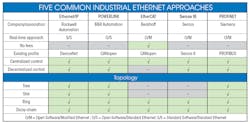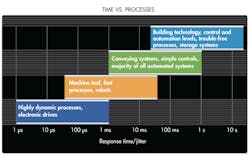Download this article in PDF format.
When choosing the Ethernet technology that might best fit your industrial system, you first need to have some base information:
• How many I/O points do you have?
• How fast do you need the information?
• What is my span of control (the amount of devices being controlled off how many I/Os)?
• What training or knowledge do people have in terms of operating this equipment?
This information might help specify a particular Ethernet, but it might also indicate multiple types of Ethernet could work for you. “Ultimately, it’s like mailing a package,” says Erick Rudaitis, marketing director engineer for Parker Hannifin. “It might take various ways in getting to you—the post office, UPS, FedEx, DHL, etc.—but the package will arrive.”
First, one of the big difference between the Ethernet and industrial Ethernet is soft and hard real-time. “A real-time system guarantees that all inputs, outputs, and computations process within a specific time constraint, often referred to as a deadline,” says Matteo Dariol, a product developer for Bosch Rexroth. “A hard real-time system considers missing a deadline to be a total failure. A soft real-time system, on the other hand, accepts missing some deadlines even if it degrades the output quality. Every time that a PLC program compiles, it calculates if the needed resources are available to perform all of the operations that we are commanding. Then it comes up with a solution for meeting our desired deadline.”
Networks need to know what data is being transmitted and how often. This will indicate the bandwidth and robustness of the needed network. Furthermore, it may change the type of Ethernet that will be used. For example, Ethernet/IP and PROFINET RT are only for soft real-time requirements, according to ethernet-powerlink.org.
For a simple explanation, communication protocols make sure data gets to its destination. Data packages can become disrupted when they collide with another signal trying to use the same path at the same time. Having data not collide with other data, while ensuring that priority data is sent first and not interrupted by non-priority data, is a large concern for many communication protocols.
There are three ways to approach real-time in fieldbuses:
Standard Software/Standard Ethernet (S/S): This is based on Transmission Control Protocol/Internet Protocol (TCP/IP), which is a basic communication language or protocol used for the internet and intranet layers. Real-time mechanisms are embedded into the top layer. Note that this approach can have limitations in performance.
Open Software/Standard Ethernet (O/S): It is possible to follow standards, but have a device that doesn’t work with other manufacturers. Standards in this industry do not mean the same as standard parts in the mechanical industry. The Open Software/Standard Ethernet enables companies to follow the standards in any way they like, but they have to test the device’s interoperability with other devices. This means you don’t invest extra money in royalties, because it is open, and has been tested that the device will work well with other manufacturers. Working well with other manufacturers is often referred to as a plugtest or plugfest. However, this approach sometimes demands a proprietary software controller to prevent latency problems.
Open Software/Modified Ethernet (O/M): Using a new protocol and some hardware, this approach takes advantage of existing Ethernet and guarantees hard real-time. In addition, software is often published freely in the public domain.
The Industrial Internet of Things (IIoT) and the increasingly automated manufacturing line are making networking and communication protocols more important. The result seems to be an endless supply of protocols to talk about.
This article will outline some differences in industrial Ethernet. However, about 30 types of industrial Ethernet systems in the market, so let’s focus on the five that are often touted for technical aspects, cost, standardization status, and strategic market considerations: PROFINET (process field network), Ethernet/IP, POWERLINK, EtherCAT, and Sercos III.
What follows is a brief description of these five industrial Ethernet options, and what approach, company, and features are associated with each.
Ethernet/IP
Developed by Rockwell Automation and the Open DeviceNet Vendors Association (ODVA), Ethernet/IP employs Common Industrial Protocol (CIP) Sync. It follows both the IEEE 1588 time-synchronization method and a standard software/standard Ethernet—TCP/IP.
Ethernet/IP lets one network cover many end points and communication between drives. It is compatible with many standard protocols—both Ethernet and internet—but has limited real-time capabilities. Despite this, the cycle times and jitter values are low enough to run servo-motor controls. Ethernet/IP’s performance is based on time instead of cycles. Thus, as long as commands are received by the stations by the deadline, it isn’t a failure.
To show how confusing communication protocols can be, CIP is used in multiple other ways. When CIP is used over a controller area network, or CAN, it is called DeviceNet. When implemented over a dedicated network, it is called ControlNet. If it is used over Ethernet, it is referred to as Ethernet/IP. Furthermore, Ethernet/IP can use TCP/IP and User Data Protocol/Internet Protocol (UDP/IP*). Using CIP protocol, Ethernet/IP also can leverage different communication mechanisms: cyclic polling, time, multicast, point-to-point, and more.
(*UDP/IP dismisses error-checking that will slow down the cycle times. For example, it isn’t too big of a deal if diagnostics and configuration data miss a few data packages. However, you want to ensure delivery of priority data, so you may not want hard real-time data to be delivered with UDP/IP.)
POWERLINK
Developed by B&R Automation, but currently managed by the Ethernet POWERLINK Standard Group, POWERLINK employs a cyclical protocol—time-synchronization method—and an Open Software/Standard Ethernet approach.
Essentially, POWERLINK uses a master to control the timing of the network that dictates when data is sent from each node. This IEEE 1588 time-synchronization method keeps highly precise time across a network. The master superimposes a time slot to send data over a carrier-sense multiple-access/collision-detection (CSMA/CD) mechanism. The CSMA/CD consists of rules that define how long a device should wait if there’s a collision. The controller polls the drives with an allocated cycle period.
Since all of the devices are seen at once, priority data is able to be sent first. In the remaining cycle time, any general data is sent. In addition, it uses multiplexing—multiple signals are combined into one signal over a shared medium. This is a local area network (LAN) that shares the bandwidth available with all transmitting stations.
EtherCAT
Developed by Beckhoff Automation, EtherCAT uses a summation frame method and an Open Software/Modified Ethernet approach.
With the summation frame method, all nodes send one telegram that travels from node to node along a ring, collecting the nodes’ response along the way. This method stands out because the telegram, which also might be called a frame, is segmented and goes through all of the nodes. Each node reads data addressed to it and inserts a response onto the telegram (this is hardware-based). An application-specific integrated circuit (ASIC) or field-programmable gate array (FPGA) are used on the slave end of the process.
As production becomes more advanced through automation and robotics, hard real-time and speeds will become more important.
This approach may have added cost. While EtherCAT uses an Open Software/Modified Ethernet, the EtherCAT Technology Group could be called a hybrid between an association and a private partnership. Despite this, EtherCAT generally works well with other vendors. One simply needs to be sure to have drivers that are supported. In addition, EtherCAT doesn’t require membership fees. (Note that there are often fees associated with the other Ethernet types presented in this article.)
Sercos III
Managed by Sercos International for ongoing development and compliance, this Ethernet approach uses the summation frame method and Open Software/Modified Ethernet.
Sercos III operates without hubs or switches that reduce cycle times. Each station has an ASIC or FPGA. This can work better for closed ring or line (daisy-chain) topography. Data is processed while passing through a device using different types of telegrams for different communication types. With a full-duplex system (two parties can communicate simultaneously), a daisy chain acts like a ring. A ring allows redundant data transfer. In addition, two communication ports enable direct cross-traffic. Sercos III processes data twice per cycle, which means devices are able to communicate with each other without going through the master.
PROFINET IRT
Developed by Siemens and the member companies of the PROFIBUS user organization, PROFINET IRT combines synchronized switches, which control communication, with polling enabled by an Open Software/Modified Ethernet approach. It is interesting to note that PROFINET is widely used in Siemens and GE controllers and equipment, but not many vendors seem to support it outside of these two companies.
Evolutions in Ethernet
Last year, ABB, Bosch Rexroth, B&R, Cisco, General Electric, KUKA, NI, Parker Hannifin, Schneider Electric, SEW-EURODRIVE, and TTTech collaborated under the umbrella of the Industrial Internet Consortium (IIC) and OPC Foundation (Object Linking and Embedding for Process Control) to adopt the OPC unified architecture over a time-sensitive network (OPC UA TSN). The group of companies is aiming to make this a unified standard to support future generations of products.
Continuing to develop standards will be important to evolve Ethernet, especially when safety is involved. “There are more safety networks coming into play,” says Rudaitis. “Companies are now putting safe functions over Ethernet versus a separate system.”
To make sure things keep working if a connection is lost, redundancy is built into some networks. However, this often comes at a price. The ring topology is a cost-effective way to work redundancy into a network.
As with most things, you need to ask the right questions when looking for an Ethernet solution. It is important to know the cycle time, bandwidth, and clock accuracy (if you are using a protocol that includes it) to make sure the network will operate at the speed necessary for your application. Know what type of architectures and networks companies use, as that might dictate what type of equipment works on them.
Certain manufacturers offer plugtest equipment and other companies make third-party products to help connect product that might not work well together. For example, Anybus is a third-party solution that is able to communicate between any fieldbus or industrial Ethernet, or wireless network. This might help bridge a gap between equipment that doesn’t communicate well with each other, or gap between legacy and new machines.
Other factors to consider are whether the software and Ethernet are standard, open, or modified. Ultimately, talk to your IT people and form a partnership. Too often, the IT and production line don’t talk while they have beneficial information for each other. Understanding the benefits of how the network is laid out—its topology—might leave one machine with the power to shut down an entire line.
In addition, hardware and licensing might cause you to invest more money than you anticipated if you don’t ask the provider from the start or provide them with your modifications and upgrade plan for your particular plant. Lastly, while Ethernet looks like it is taking over, there are other options. This is where having a knowledgeable network professional on your side might keep you from yelling, “Why can’t I just push the button and have it work!”





